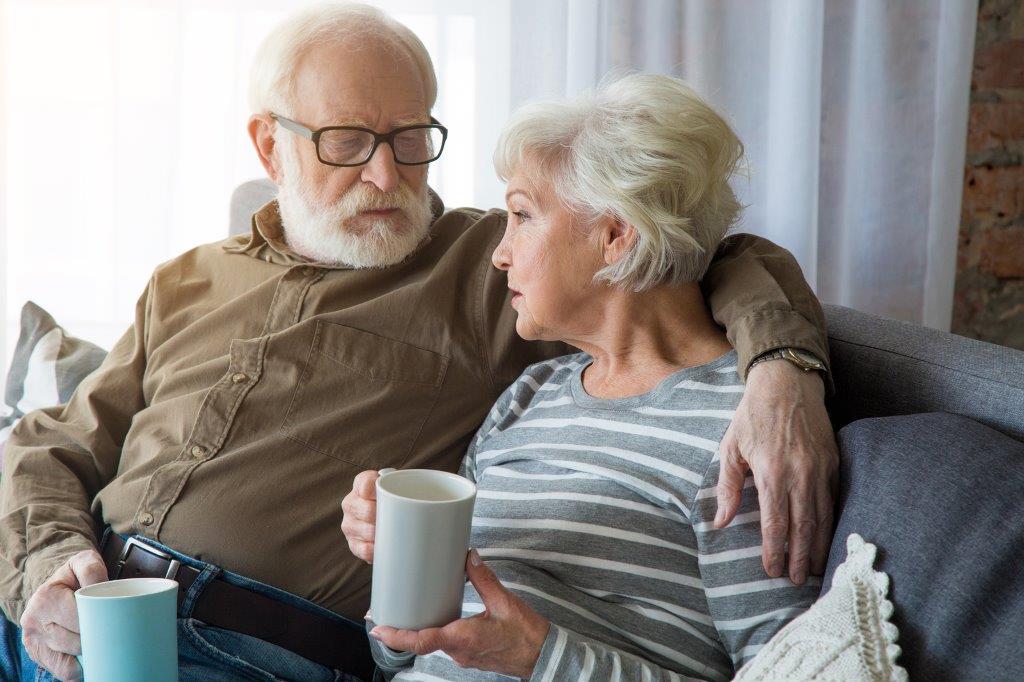
This couple is sitting and enjoying quiet conversation and a cup of coffee as they enjoy each other and the home they occupy longterm as they age in place in comfortable surroundings
Aging in place is a fluid concept. what we do today doesn’t necessarily match or coincide with what we did just a short time ago. our needs may be different, along with our abilities or requirements, and our attitudes or perspective may have changed as well.
We are constantly being introduced to news items and worldly events. We can’t help but be shaped, or at least influenced, by the reporting of these items and events. The recent COVID-19 outbreak and the way we’ve adapted to it is such a case. We have learned to age in place a little differently and to venture out into the world much more cautiously.
Aging in place has taken on a new dimension and importance for us. A couple of months ago many people probably had not considered themselves to be aging in place or given the concept much thought at all. Yet here they are weeks later, looking back, and they notice that they have spent a considerable amount of time in their homes – for better or for worse depending on how their homes may have allowed them to be comfortable in that space.
Comfort, convenience, safety, accessibility, and enjoyment are the top five attributes of aging in place, and many people are just now or quite recently discovering that their homes can provide many, if not all, of these. Prior to being requested to remain at home much or essentially all of the time, they may not have placed much stock in whether their home could accommodate them for extended periods of time. They may have discovered, much to their surprise, that they were aging in place rather well or that they could make the necessary accommodations to do better than they were.
This is why aging in place is fluid. Our requirements and needs today aren’t necessarily what they were yesterday last week or a month ago. Nor will they remain static into the future necessarily.
Our mobility needs, our sensory changes, and the perception of our world around us certainly are subject to change as the days pass. Just within the last couple of months and being in our home so much, we may have noticed that we have had to adapt our activities to the way our home was configured, or we discovered that surprisingly our homes served us quite well and that we liked them more than we even suspected we did.
As we age or get older, our needs are likely to change. Our vision, hearing, gait, stride, and pace of living may fall off a little, but our homes should be able to accommodate us so that the changes are relatively seamless. When there is a noticeable conflict, this is the time to note how the home needs to be improved for the future, and we need to be summoned to help them accomplish the desired changes.
If we were to ask people how well their home can serve their needs, we might get a mixed response. This would be especially true if we asked them four or five months ago. Now that they’ve had an opportunity to see what their homes can provide, they either love their homes even more or are at a noticeable stage of conflict with their homes. Hopefully, this latter case is not true but if it is, what an opportunity we have to help make things better. Whether we will be faced with another shelter in place situation in the next year or two, or an illness or injury confines a person to their home, or they have reached a stage in life where remaining at home and aging in place for the balance of their life is what they want or need to do, having a home that provides the safety, comfort, and mobility that someone deserves is our objective.
Notice that our concept of aging and what is old varies by what we’re discussing. Some of us do not like to be described or thought of as old, and the idea of aging may not seem that pleasant to our ears. Nevertheless, not everyone gets to enjoy old age so those of us who attain it should embrace it and welcome it even if we have various challenges.
Speaking of age, we happily talk about aged wine, whiskey, cheese, artwork, cigars, and other items where we feel that age is an attribute. We talk about the age of various insurance policies. we talk about how long we have been a client or customer of a certain merchant or company, feeling that gives us a certain status or additional rights.
When we sell an item, we frequently discuss it in terms of its age – either when we purchased it or how old it is and how long it’s been performing at an acceptable quality. Sports records are noted for when they were achieved and how long it’s been since someone has equaled or come close to eclipsing that mark. We talk about how long it’s been since a championship has been won by a particular team or the last time a particular weather event occurred.
It’s not just us who are aging but our trees, gardens, landscaping homes, cars, children, and everything else dear to us. It really couldn’t be any other way. Therefore, aging in place is an acknowledgment that we have additional years projected to live and that we want to do them in a home that we find comfortable, safe, convenient, accessible, and enjoyable for our needs and those of anyone whom we might invite to visit us or share in what we have to offer.
Aging in place is as real as it gets even if we don’t label or identify with – it’s still happening.
